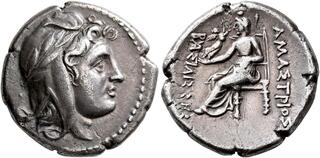| Leu Numismatik AG > Auction 15 | Auction date: 1 June 2024 |
| Lot number: 80 Price realized: This lot is for sale in an upcoming auction - Bid on this lot  | Show similar lots on CoinArchives Find similar lots in upcoming auctions on |
| Lot description: KINGS OF PAPHLAGONIA. Amastris, circa 300-285 BC. Stater (Silver, 22 mm, 9.58 g, 1 h). Head of Mên to right, wearing Phrygian cap adorned with a laurel wreath. Rev. ΑΜΑΣΤΡΙΟΣ - ΒΑΣΙΛΙΣΣΗΣ Aphrodite seated left on throne, holding Nike, who crowns her with wreath, in her right hand and lotus-tipped scepter in her left. F. De Callataÿ: Le premier monnayage de la cité d'Amastris, in: SNR 83 (2004), p. 67 and pl. 9, 16a (this coin, D5/R5). HGC 7, 353. SNG Delepierre 2477. SNG von Aulock 6799. Beautifully toned and struck in high relief, a lovely example of this earliest independent coinage of a female ruler in history. Slightly porous and with minor marks, otherwise, good very fine. Ex Giessener Münzhandlung 45, 4 April 1989, 113. As the niece of the last Achaemenid king and wife of two Diadochi and a tyrant, the Persian princess Amastris witnessed the tremendous upheavals of early Hellenism. Born around 340 BC as the daughter of Oxyathres, a brother of Darius III (336-330 BC), she was a direct descendant of Darius II (423-404 BC) and thus came from the highest Persian nobility. Amastris, along with the entire family of Darius III, fell into Macedonian captivity after the Battle of Issus in 333 BC and was married to the distinguished general Krateros by Alexander in the mass wedding at Susa in 324 BC. Like all high-ranking officers of Alexander except Seleukos, Krateros divorced his Persian wife after the king's death, who then married Dionysios, the tyrant of Herakleia Pontika. After her husband's death in 305 BC, she served as queen regent for her eldest son Klearchos under the suzerainty of Antigonos Monophthalmos. In 302 BC, Amastris married the Diadoch Lysimachos, who shortly thereafter defeated Antigonos in alliance with Seleukos I, only to leave his new wife immediately and marry Arsinoe II, the daughter of Ptolemy I. Shortly thereafter, the now twice-abandoned queen founded a new city by synoecism of the towns Sesamos, Kytoros, Kromna, and Tios, which she named after herself - an extraordinary act, as it represents the only known case in antiquity where a queen independently founded and named a city after herself. Undoubtedly, Amastris positioned herself within the early Hellenistic tradition of city foundations, evidently considering herself an equal queen to her male rivals. Although Greek aristocratic women occasionally exerted great political power in the Hellenistic era, Amastris' Persian heritage is likely evident here, as women in Achaemenid society generally held a more independent and influential role than in Greek society. Amastris' position in Herakleia Pontika was so formidable that she eventually became the first woman in history to also mint coins in her own name, of which we have here a particularly well-preserved example. Remarkably, nothing on these coins indicates her role as regent for her son; on the contrary, she appears unambiguously as a βασίλισσα, an independent queen. Therefore, through the figure of the former Persian princess Amastris, we witness not only early Hellenistic history but also an important moment in global cultural history, as the earliest independent coinage by a female ruler holds evident significance. However, the reign of the queen did not end well, for when she died in 285, her sons Klearchos and Oxyathres were suspected of murder by Lysimachus and executed. Nevertheless, her legacy lives on both in her coins and in the founding of her city, which still bears the name Amasra to this day. Estimate: 3500 CHF |  |



